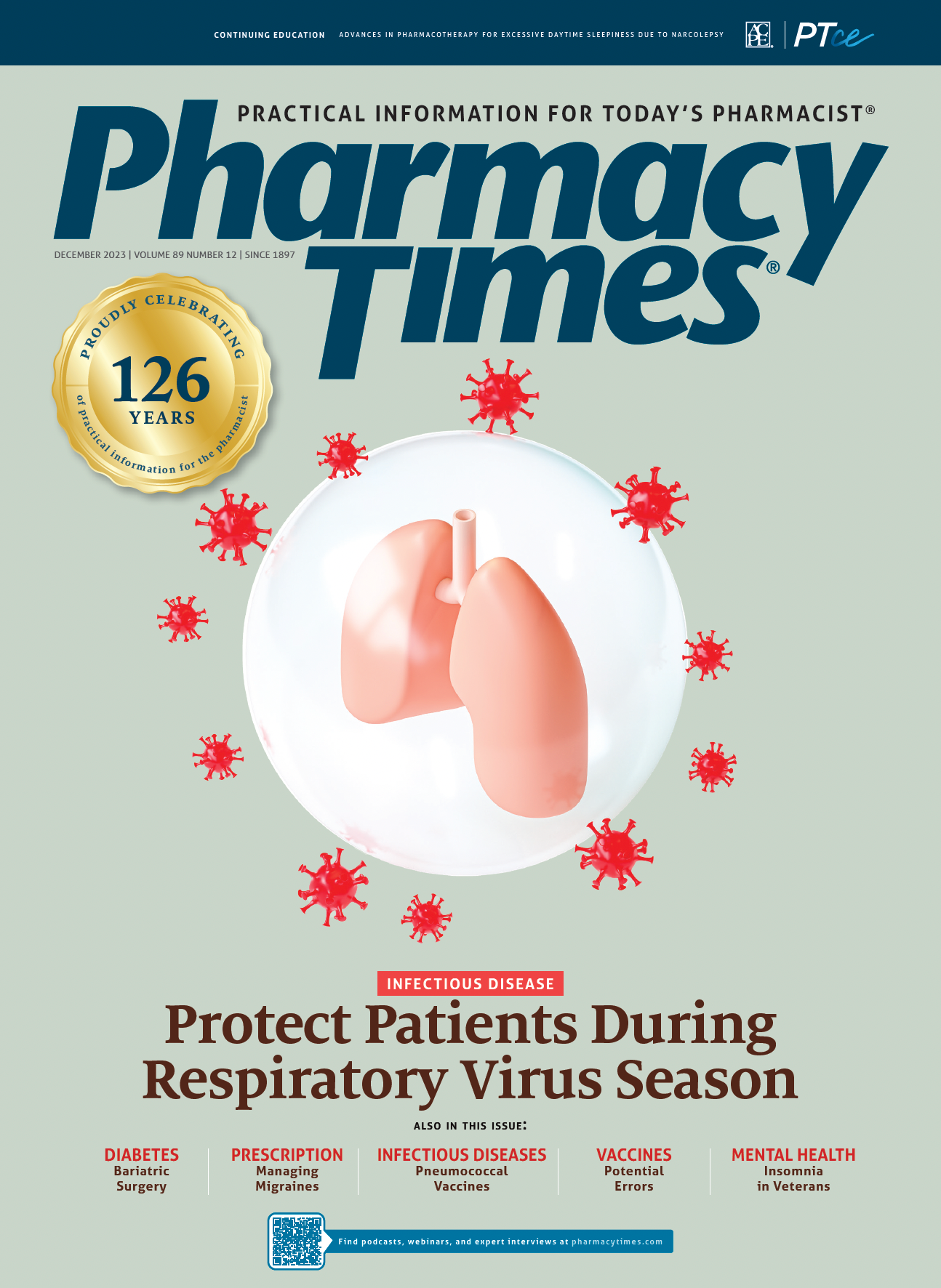Publication
Article
Pharmacy Times
Protect Patients During Respiratory Virus Season
Author(s):
Influenza, COVID-19, and respiratory syncytial virus will all peak in the coming months.

Winter is upon us, and with it comes respiratory viruses. Influenza, COVID-19, and respiratory syncytial virus (RSV) infections all begin climbing during the fall and peak in the winter months. COVID-19 may also have a second, smaller peak in the summer months.1
Most experts believe that these viruses spread primarily through tiny droplets when individuals with infections cough, sneeze, or talk. These droplets can land in the mouths or noses of those nearby. Less often, a person might contract these viruses by touching a surface or object with a virus on it and touching their own mouth, nose, or possibly their eyes.1
Protecting patients during this time of year is an integral part of the pharmacy profession. The best thing we can do for patients is to educate them on the various ways to prevent illness from these viruses. The most important and effective way to prevent these viruses is to vaccinate.
Image credit: terovesalainen | stock.adobe.com

Influenza Virus
There are 4 types of influenza viruses: A, B, C, and D. Influenza A and B viruses cause seasonal epidemics of disease (known as flu season) almost every winter in the United States. Influenza A viruses are divided into subtypes based on 2 proteins on the surface of the virus: hemagglutinin (H) and neuraminidase (N). There are 18 different H subtypes and 11 different N subtypes (H1 through H18 and N1 through N11, respectively).2
The CDC estimates that there were between 26 million and 50 million influenza illnesses between October 1, 2022, and April 30, 2023. During that same time, the CDC estimates there were between 12 million and 24 million medical visits related to influenza and 290,000 to 670,000 influenza-related hospitalizations. In addition, the CDC estimates that 17,000 to 98,000 individuals died from influenza-related complications.3
Influenza vaccines for the US 2023-2024 season will contain the following4:
- Egg-based vaccines
- A/Victoria/4897/2022 (H1N1)pdm09–like virus
- A/Darwin/9/2021 (H3N2)–like virus
- B/Austria/1359417/2021 (B/Victoria lineage)–like virus
- B/Phuket/3073/2013 (B/Yamagata lineage)–like virus
- Cell- or recombinant-based vaccines
- A/Wisconsin/67/2022 (H1N1)pdm09–like virus
- A/Darwin/6/2021 (H3N2)–like virus
- B/Austria/1359417/2021 (B/Victoria lineage)–like virus
- B/Phuket/3073/2013 (B/Yamagata lineage)–like virus
COVID-19
COVID-19 is a disease caused by the SARS-CoV-2 virus. It can be extremely contagious and spreads quickly. Over 1 million individuals have died from COVID-19 in the United States since the virus’ emergence early in 2020. COVID-19 most often causes respiratory symptoms that can feel like a cold, influenza, or pneumonia, although it may attack more than the lungs and respiratory system. Other parts of the body may also be affected by the disease. Most patients with COVID-19 have mild symptoms, but some become severely ill.5
Because COVID-19 is a new illness, its annual burden in the United States is still unpredictable. Since 2020, there have been an estimated 1,150,119 deaths attributed to COVID-19.6
The FDA has approved and authorized for emergency use updated COVID-19 vaccines (2023-2024 formula) that include a monovalent (single) component that corresponds to the Omicron subvariant XBB.1.5 of SARS-CoV-2. These vaccines were updated to provide better protection against COVID-19 caused by circulating variants.7
RSV
RSV is a common respiratory virus that usually causes mild, cold-like symptoms. However, it can be dangerous for infants, toddlers, and older adults.8 RSV is an enveloped, nonsegmented, negative, single-stranded RNA virus.9
RSV is a major cause of lower respiratory tract infection (LRTI) in children. In 2015, the global burden in children younger than 5 years was estimated to be approximately 33 million RSV-associated LRTI episodes, 3 million hospitalizations, and approximately 60,000 in-hospital deaths but up to 118,200 estimated deaths when accounting for community-based mortality.10
RSV can also be dangerous in older adults. In the United States, it is estimated that 60,000 to 120,000 older adults are hospitalized with RSV every year and approximately 6000 to 10,000 older adults die from RSV complications.11
The FDA approved the first RSV vaccine for use in the United States on May 3, 2023. This vaccine is approved for the prevention of LRTI caused by RSV in individuals 60 years or older.
Preventing Infection
In addition to keeping current on vaccinations, patients can practice other methods of preventing the spread of viral infections.
Advise patients to wash their hands often. Guidelines recommend that hands be washed often with soap and water for at least 20 seconds. Scrub the palms and fingernails, in between the fingers, the backs of the hands, and up to the elbows. If soap and water are not available, use a sanitizer with at least 60% alcohol.
To help prevent infections, advise patients to keep their hands away from their eyes, nose, and mouth. To prevent the spread of germs when coughing or sneezing, cover the mouth and nose with a tissue and wash your hands. If a tissue is unavailable, cough or sneeze into the inside of your elbow.
Although COVID-19 pandemic precautions have generally ended, it is still good practice to maintain a distance of at least 6 feet between individuals when viruses are circulating in the community. Advise patients to stay away from others and not shake hands or touch others when they are not feeling well.
High-touch objects and surfaces should be disinfected frequently. These include doorknobs, light switches, tables, countertops, desks, toilets, faucets, sinks, phones, and computer keyboards.
Sleep is also important to keep the immune system strong and prepare it to fight off foreign invaders. Consuming a healthy diet, exercising regularly, and staying hydrated also contribute to a healthy immune system.
Medications and Supplements
OTC medications to manage the symptoms associated with these viral infections can include pain relievers/antipyretics, decongestants, saline nasal spray, cough suppressants, expectorants, sprays/lozenges for sore throat, etc.
Supplements to boost immune response and manage symptoms can include vitamin C, zinc, probiotics, echinacea, elderberry, and honey.
For patients with more severe infections, physicians may prescribe an antiviral medication to help the body fight off the infection. Pharmacists should advise patients to take the antiviral as prescribed without skipping doses or stopping treatment early.12
Conclusion
Vaccination is the key to preventing COVID-19, influenza, and RSV. While vaccinating, pharmacists can speak to patients about best practices for other methods of preventing viral illnesses. Encourage patients to make sure they have everything they need at home during the season to help them stay healthy and manage symptoms when needed.
References
1. Couture A, Iuliano AD, Chang HH, et al. Estimating COVID-19 hospitalizations in the United States with surveillance data using a Bayesian hierarchical model: modeling study. JMIR Public Health Surveill. 2022;8(6):e34296. doi:10.2196/34296
2. Types of influenza viruses. CDC. Updated March 30, 2023. Accessed October 28, 2023. https://www.cdc.gov/flu/about/viruses/types.htm
3. 2022-2023 U.S. flu season: preliminary in-season burden estimates. CDC. Updated September 28, 2023. Accessed October 28, 2023. https://www.cdc.gov/flu/about/burden/preliminary-inseason-estimates.htm
4. Information for the 2023-2024 flu season. CDC. Updated October 24, 2023. Accessed October 28, 2023. https://www.cdc.gov/flu/season/faq-flu-season-2023-2024.htm
5. COVID-19 (2019 novel coronavirus) research guide. CDC. Updated September 29, 2023. Accessed October 28, 2023. https://www.cdc.gov/library/researchguides/2019NovelCoronavirus.html
6. United States COVID-19 hospitalizations, deaths, emergency department (ED) visits, and test positivity by geographic area. CDC. Updated October 28, 2023. Accessed October 28, 2023. https://covid.cdc.gov/covid-data-tracker/#maps_deaths-total
7. COVID-19 vaccines for 2023-2024. FDA. Updated October 4, 2023. Accessed October 28, 2023. https://www.fda.gov/emergencypreparedness-and-response/coronavirus-disease-2019-covid-19/covid-19-vaccines-2023-2024
8. What is respiratory syncytial virus (RSV)? National Foundation for Infectious Diseases. Updated September 2023. Accessed October 28, 2023. https://www.nfid.org/infectious-disease/rsv/
9. Erickson EN, Bhakta RT, Mendez MD. Pediatric bronchiolitis. In: StatPearls. StatPearls Publishing; 2023. Accessed October 28, 2023. https://www.ncbi.nlm.nih.gov/books/NBK519506/
10. Shi T, McAllister DA, O’Brien KL, et al; RSV Global Epidemiology Network. Global, regional, and national disease burden estimates of acute lower respiratory infections due to respiratory syncytial virus in young children in 2015: a systematic review and modelling study. Lancet. 2017;390(10098):946-958. doi:10.1016/S0140-6736(17)30938-8
11. RSV in adults. American Lung Association. Updated September 26, 2023. Accessed October 28, 2023. https://www.lung.org/lunghealth-diseases/lung-disease-lookup/rsv/rsv-in-adults
12. Antivirals. Cleveland Clinic. Updated May 11, 2021. Accessed November 6, 2023. https://my.clevelandclinic.org/health/drugs/21531-antivirals
About the Author
Kathleen Kenny, PharmD, RPh, earned her doctorate from the University of Colorado Health Science Center. She has more than 25 years of experience as a community pharmacist and works as a clinical medical writer based in Homosassa, Florida.






